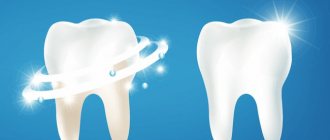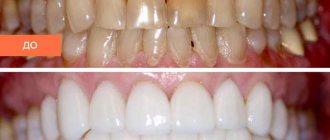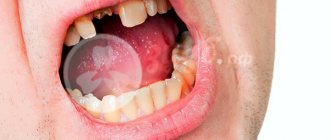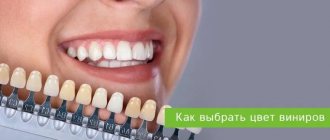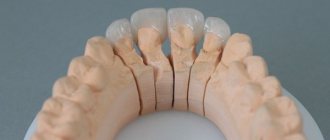Dental enamel implantation is a new and progressive direction in aesthetic dentistry. The essence of the procedure is to restore the enamel coating by fixing special orthopedic devices - veneers - to the front of the teeth. These are thin plates made of ceramics that are used to correct the color and shape of teeth.
In addition to the fact that the thickness of the coatings is only 0.3-0.6 mm, veneers are similar in elasticity and strength to natural enamel and act as an infallible tool for giving teeth exemplary evenness and aesthetics. Installing veneers helps eliminate curvatures, hide pigment spots, chips, cracks and a number of other defects that have appeared on the surface. Although ceramic plates do not provide a therapeutic effect, they improve the appearance of teeth and make a smile impeccable.
Causes of enamel destruction
There are quite a lot of factors that destroy enamel. The most common ones are:
- Poor oral and dental hygiene.
- The use of hygiene products containing aggressive substances that cause demineralization of enamel.
- Disruption of the digestive system.
- Abuse of sweet, sour foods, which chemically affect the top layer of enamel.
- Systematic consumption of energy drinks.
- Smoking. Tobacco contains nicotine, which destroys enamel.
- An incorrect bite causes the tooth enamel to wear away.
- Injury to teeth.
Why you should get veneers
Implantation of enamel coating can eliminate functional and cosmetic defects and give a person a charming Hollywood smile.
The advantages of installing ceramic plates are undeniable:
- reliable protection. With minimal grinding, teeth receive a wear-resistant and durable protective coating;
- invulnerable aesthetics. The thinnest plates fully reproduce natural enamel due to the increased light conductivity of the material;
- versatility. An extensive color palette makes it possible to choose a shade that is in no way different from the color of neighboring healthy teeth;
- quick effect. You can get a dazzling smile in a couple of visits to the dentist, bypassing long-term wearing of braces and other painful procedures;
- durability. If the rules of care for structures are followed, they retain their original appearance for up to 15 years or more.
The specialists of our clinic in St. Petersburg install veneers with a quality guarantee. Regardless of congenital or acquired defects that need to be eliminated, doctors guarantee success in the most difficult situations.
Benefits of implantation
The main advantages include:
- The ability to restore tooth enamel at different degrees of destruction.
- Teeth regain their natural smoothness and shine.
- Strengthening dental health from exposure to external irritants.
- Prevention of the development of dental diseases, especially caries.
Indications for the use of enamel implantation:
- damage to the enamel, disrupting the aesthetics of the tooth;
- decrease in the level of minerals and salts in tooth enamel;
- development of pathology, accompanied by the appearance of spots on the enamel;
- expansion of interdental gaps;
- malocclusion.
Fixed prosthetics with veneers: installation features
Artificial enamel substitutes are a winning option for solving problems with increased abrasion and deterioration of the color of the natural enamel layer, abnormalities in the outline and location of teeth and other aesthetic defects.
The procedure is painless and occurs in several stages:
- preparation for prosthetics. If necessary, the doctor removes carious formations, renews previously installed fillings, and performs sanitation of the oral cavity;
- then impressions are taken from the jaw and sent to a dental laboratory for the production of plates;
- finished structures using durable dental glue are fixed to the surface of the teeth being restored.
After fixation, the doctor checks the correctness of the bite and evaluates the accuracy of the contact of the implanted units with the adjacent teeth and those located on the opposite jaw. If inconsistencies are identified, adjustments are made. At the end of the procedure, the doctor removes excess adhesive.
Enamel implantation does not cause pain and does not require the use of anesthetics, therefore it is suitable for patients with allergies to painkillers. In addition, a healing abutment is not required for enamel implantation.
Other ways to restore enamel
- Filling, which is prescribed in the complete absence of a layer of enamel. The filling material is applied in a thin layer to the tooth, and after hardening, the chewing element takes on a healthy appearance with smooth and shiny enamel.
- Fluoridation. This is the most famous and accessible method of restoring enamel, in which a substance containing fluoride is applied to the teeth. Fluoride comes in gel form. After fluoridation, teeth become smooth and shiny.
- Microprosthetics, when a veneer or lumineer is attached to damaged teeth. The procedure is effective, but expensive.
- Remineralization. A procedure in which calcium phosphate is applied to the teeth. Over time, the applied substance becomes durable and is able to protect teeth from external irritants. This method of restoring enamel is used only when it is partially destroyed. If there is a complete absence of enamel, the method is not effective.
At the first signs of tooth hypersensitivity, you should immediately contact a dentist, who can determine the cause of tooth hypersensitivity. After diagnosis, the doctor will prescribe a course of treatment.
How much does tooth enamel implantation cost?
Dental enamel implantation is a relatively expensive pleasure. The cost of restoration of one unit varies from 14-15 thousand rubles and more, depending on the material and technology for making veneers. If there is a complex defect, the price of cosmetic prosthetics increases accordingly.
Prices for the installation of turnkey ceramic onlays differ from the cost of a dental implant and are calculated for each patient separately, taking into account a number of factors:
- type of material used for the manufacture of plate products;
- method for creating orthopedic products. Onlays can be made from composite or filling materials directly in the orthopedist’s office, as well as in a denture workshop from ceramics or zirconium;
- the number of problem units in need of restoration;
- complexity of the preparatory process;
- scope of work of the implantologist.
Although the designs belong to the upper price category, their superior characteristics and durability fully justify the costs incurred.
Make an appointment
Correction of crooked teeth
As a rule, such a defect can be corrected using an artistic method only in case of minor deviations from the norm.
In case of protruding units, crowding or partial rotation, the patient is first sent to the orthodontist for a consultation. It is quite possible that the installation of braces or aligners will be initially recommended, and only after a course of treatment does it make sense to return to the issue of restoring aesthetics. Correction of malocclusion or dentition disorders can be successfully corrected at any age, including adults. Dentika specialists select the best option, taking into account the main task, the wishes of clients and the individual characteristics of the dental system. Modern dentistry carries out the restoration of front teeth in various ways, which allows restoration of any degree of complexity.
Alternatives
There are clinical cases when it is impossible to restore a tooth. If half of the tooth or the entire crown part is destroyed, a crown is already needed. The root is damaged - you have to choose between:
- Implantation
A metal pin – an implant – is screwed into place of the removed root. A crown is put on it. Neighboring teeth are not involved. The implant performs the functions of a natural root. It comes with a lifetime warranty
.
- Bridge prosthesis
The artificial tooth is located between two crowns. Load-bearing teeth are ground down for crowns. Does not prevent bone loss. Should be changed every 5-7 years
.
Indications and contraindications
Recently, dental varnishes have become in demand.
Their use is considered appropriate for the following indications :
- the presence of carious lesions at the spot stage;
- enamel hypersensitivity;
- surface microdefects;
- high permeability (thinning) of enamel;
- pigmentation of crowns as a result of consuming coloring products, bad habits, or after taking certain medications;
- fluorosis;
- pulp diseases.
The use of varnish allows you to temporarily solve the problem of color mismatch between fillings and the main surface of the tooth.
The use of correctors is not always possible. contraindications for this :
- age up to 19 years;
- intolerance to components;
- allergic manifestations;
- period of pregnancy and breastfeeding;
- for some types of varnishes – high sensitivity of enamel;
- severe damage to crowns: carious cavities, large chips;
- pathology of periodontal tissue;
- advanced dental diseases;
- dental injuries.
What drugs are used for the procedure
Most dentists that offer this technique today use the drug InnoDent1, developed about four years ago. It is interesting that the product is positioned as Swiss, although in fact it was invented by a Kazakh scientist and biotechnologist. According to the creator, Swiss raw materials are used for the production of InnoDent, so the information is partly true, but on the other hand, this is a kind of marketing ploy. Today, about 40% of the product is sold in Kazakhstan, and 60% goes abroad, mainly to Russia and Ukraine.
The drug contains an analogue of the human protein amelogenin. According to the manufacturer, it is this substance that promotes the formation of enamel. Interestingly, amelogenin is absent from already destroyed tissues, and, in fact, by applying the product to the teeth, doctors simply start the process of their natural restoration. The mechanism of action of the active component is as follows: it interacts with human saliva, due to which a regular crystal lattice of calcium and phosphate minerals is built on the surface of the tooth.
Swiss raw materials are used for the production of InnoDent
The manufacturer emphasizes that the use of InnoDent will not give an instant result, which, for example, can be achieved by performing direct restorations with composite material. The process of tissue regeneration is slow, and you need to be patient and wait about a month, but the areas of enamel restored with this drug have natural strength, shine and natural color.
Is it possible to carry out the procedure at home?
The company that sells the enamel implantation product offers not only drugs for professional use in dentistry, but also products for home use. For example, the InnoDent De-Senz set. This complex is suitable for all people with sensitive enamel, non-carious dental lesions (wedge-shaped defect, erosion, hypoplasia, fluorosis), as well as pregnant and lactating women. The product must be used once, i.e. One application will be enough. The volume of the bottle is enough to treat 32 teeth. After 3 days, sensitivity will decrease, but the maximum effect should be expected only after a month. The result lasts from 9 months to 3 years.
This complex is suitable for all people with sensitive enamel
When is it worth getting a tooth augmented?
Sometimes, patients don't even realize how a small procedure can change the aesthetics of their smile. Most often, this happens if there are gaps between the teeth. Diastema is an indication for tooth augmentation, but there are also more complex cases:
- chips and cracks;
- injuries;
- fractures;
- pathological abrasion;
- destruction of the coronal part (partial or complete).
Prices
Aesthetics
- Professional teeth whitening using the “Zoom” device (up to 20 teeth) I category of complexity
To order - Professional teeth whitening using the “Zoom” device (up to 20 teeth) II category of complexity
from 30 000
- Whitening (1 tooth)
950
- Home whitening (set when using ZOOM)
15 000
- Making a tray for whitening (1 jaw)
10 000
- Skyce fixation (1 tooth)
2 000
To make an appointment, call:
- On Izmailovskaya
+7(495)
226-3-888
+7(985) 226-3-888 - On Shchelkovskaya
+7(495)
924-45-44
+7(985) 924-45-44 - On Ryazansky Prospekt
+7(495)
728-03-33
+7(903) 728-03-33 - On Aviamotornaya
+7(495)
647-6-333
+7(903) 247-6-333 - On Rokossovsky Boulevard
+7(495)
226-5-888
+7(985) 226-5-888 - or
Leave a request
and we will call you back
Cost of treatment
Dental enamel implantation in dentistry has a low cost - from 2,400 rubles for the treatment of several teeth. If you want to purchase InnoDent De-Senz for home use, you will have to spend about 6,000 rubles on it, but it will be enough to treat the entire oral cavity.
Notice
: Undefined variable: post_id in
/home/c/ch75405/public_html/wp-content/themes/UltraSmile/single-item.php
on line
45 Notice
: Undefined variable: full in
/home/c/ch75405/public_html/wp-content /themes/UltraSmile/single-item.php
on line
46
Rate this article:
( 2 ratings, average: 5.00 out of 5)
implantation
- According to the official website of the manufacturer innodent.net
Expert “The technology has been on the dental services market for quite a few years, there is not a lot of information, scientifically based data and reviews about it, not all clinics in Russia offer it, so it is still difficult to objectively say how effective and safe it really is. I think time will tell whether she will be able to win the trust of specialists and patients.” Dentist therapist, periodontist Marina Igorevna Tarabanovskaya
Consulting specialist
Vagapov Zakir Irkinovich
Doctor rating: 7 out of 10 (3) Specialization: Orthodontist Experience: 16 years
Reviews
Feedback from all patients, without exception, about remineralization therapy carried out in the dental office is positive - tooth sensitivity noticeably decreases after the first procedure. The effect of enamel remineralization at home may be less pronounced if the patient does not follow the rules for its implementation.
Reviews about the use of varnishes and enamels for teeth that have a whitening effect at home are not so clear. Many consumers who have used these products on their own report a negative result - the drug is difficult to distribute evenly over the entire surface of the teeth.
Only a dentist can guarantee the high efficiency and safety of covering teeth with artificial enamel. When performing this procedure in a medical institution, not only the algorithm of necessary actions is followed, but all possible risks for the patient are taken into account.
How to apply?
Despite the wide range of such products, they all have one thing in common - the method of application .
It is best to start applying the product by first installing the retractor, after which the following steps should be taken:
- Before application, it is necessary to prepare the crowns by thoroughly cleaning them with a brush and paste to remove plaque.
- After this procedure, you should thoroughly dry the surface of the teeth , otherwise the paint will not adhere well. You can use paper or cloth napkins for this.
- The product must be shaken vigorously and applied to the crowns . The principle of coating in this case is not much different from applying decorative varnish to nails. The movements go from the gum line to the cutting edge.
- After application, you need to wait for the varnish to dry completely . On average, this period lasts 2-5 minutes. Do not close your mouth until the varnish is completely dry.
To maintain the effect for the stated 12 hours, it is not recommended to eat solid food or brush your teeth during this time.
Composition and structure of tooth enamel
Tooth enamel is one of the strongest substances in the human body and completely covers the crown of the teeth. Under the layers of enamel there is dentin and a pulp chamber with a neurovascular bundle. A mixture of increased hardness made from collagen and calcium fibers (also called dental cement) covers the entire surface of the root system.
Composition of tooth enamel:
- 96% minerals, mainly calcium phosphate in the form of hydroxyapatite crystals
- 2% organic matter
- remaining 2% water
Strength of tooth enamel:
- Surface layers are the most durable and provide protection
- Cervical area and sides - density decreases
The average density on the chewing surface is 1.5 - 1.6 mm.
In what cases is it recommended to coat teeth with varnish?
The protective properties of enamel are due to the strength of the bonds in its crystal lattice formed by calcium mineral compounds (hydroxyapatites).
In addition to performing a barrier function, this layer of crowns ensures the transparency and shine of healthy teeth when exposed to sunlight.
If the chemical bonds in hydroxyapatite prisms are weakened, mineral substances are gradually washed out from the hard tissues of the tooth (demineralization) and the enamel becomes thinner. At the same time, the affected tooth loses its shine and becomes darker.
After the completion of the physiological processes of mineralization, active proteins of the enamel matrix and stem cells disappear in the hard tissues of teeth. The absence of these structural components explains the impossibility of producing a replacement mineral coating in mature tooth enamel and the formation of new hydroxyapatite prisms in the crystal lattice.
At the initial stages of demineralization of hard tooth tissues, it is possible to slow down the rate of development of destructive processes and partially restore the damaged enamel surface artificially. For this purpose, the following treatment methods have been developed in dentistry:
- Coating the surface of teeth with gels and varnishes containing simple fluorides (NaF).
- Deep fluoridation is the saturation of hard tooth tissues with mineral compounds by treating damaged surfaces with preparations that contain complex fluorine compounds (CaF2). Thanks to this, the therapeutic effect in comparison with the use of fluoride-containing varnishes is enhanced 100 times.
- Physiotherapeutic treatment – strengthening the structure of tooth enamel by introducing fluoride and calcium ions into it using low-frequency electric current discharges (electrophoresis).
- Enamel implantation is an innovative technique developed by American scientists. Only this treatment method allows you to restore fairly large damaged areas of tooth enamel. Along with the therapeutic effect, after enamel implantation, the appearance of teeth improves - the use of this technology helps to lighten their surface by up to 10 tones.
Fluorine-containing composition can only be used as prescribed by a doctor. Indications for coating the surface of teeth with varnish are as follows:
- treatment of hyperesthesia;
- protecting teeth from the aggressive effects of acids, for example, if there is a history of gastroesophageal reflux;
- temporary anesthesia of dental units ground before installing artificial crowns;
- protection and restoration of the enamel surface after removal of braces or cosmetic teeth whitening;
- slowing down the processes of destruction in the hard tissues of the tooth in the presence of the first signs of caries formation (stain stage). The most effective results in reducing the caries process are observed when treating baby teeth.
Recent developments in the pharmaceutical industry have led to the creation of fluoride varnish, which not only helps strengthen tooth enamel, but also acts as a paint. After applying such products, a short-term cosmetic effect is achieved - the surface of the teeth is instantly evened out in color, lightened by several tones, and the painted edges of the fillings are masked.
How much does the drug cost at the pharmacy?
Fluoride varnishes, which can be used at home, can be purchased in stores and pharmacies specializing in the sale of dental materials.
The price of these products depends on their composition and manufacturer:
- Fluoride varnish (25 g bottle) – 230-250 rubles;
- Dental Paint varnish (10 ml bottle) – from 2000 rubles;
- White Enamel enamel (6 ml bottle) – from RUB 2,300;
- Color Professional enamel (pack of 6 ml) – from 2000 rubles;
- Celebrity white flash polish (pen bottle 3 ml) – 500 rub.
All of the above products, except for the drug "Fluorovarnish", allow you to temporarily whiten the surface of your teeth.
The cosmetic effect lasts for 12-24 hours and disappears when drinking carbonated drinks, solid foods, or after brushing your teeth.
What is tooth augmentation?
Dental augmentation is a dental procedure that allows you to restore the appearance of teeth and restore their lost functionality. A type of extension is artistic restoration - a technique for restoring the front teeth.
Both procedures are performed using special materials that are visually similar to the texture of natural enamel. The restored unit has the same shade and texture as natural dental tissue, is highly durable and lasts for at least 10 years.
